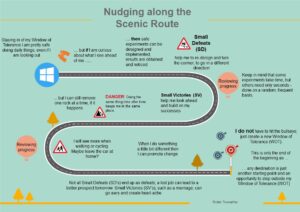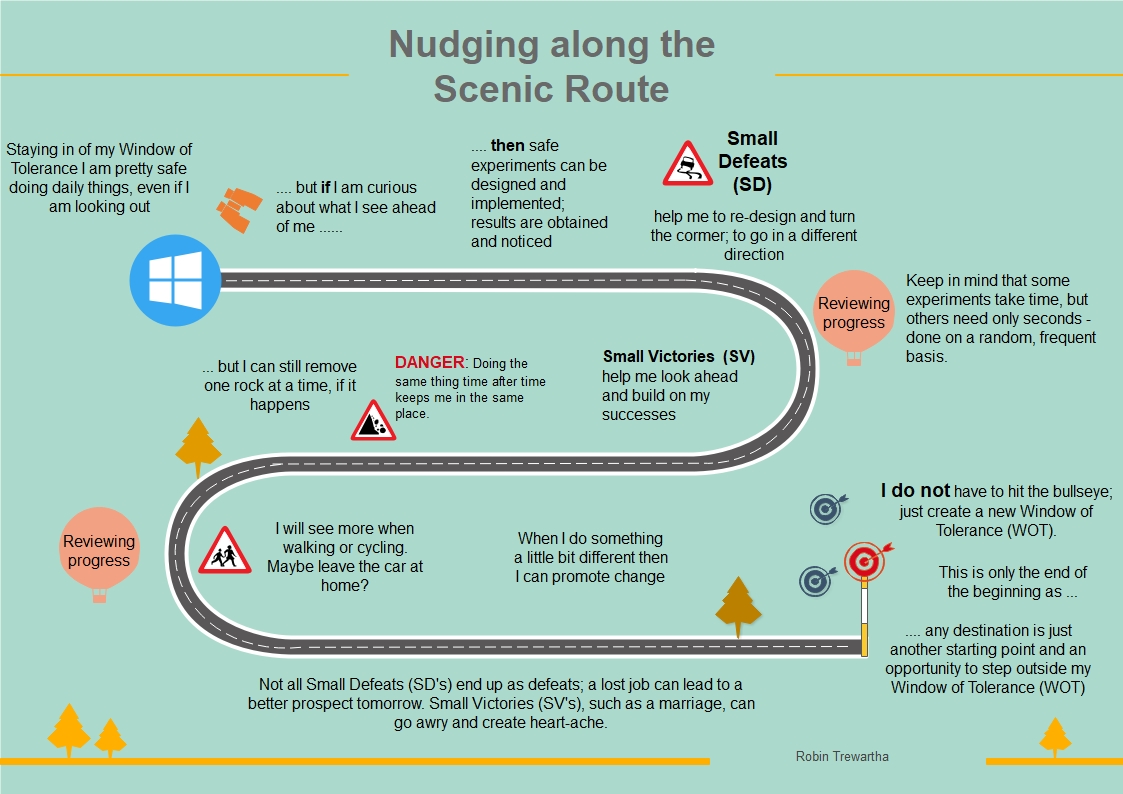My Welcome page has led to a few questions from readers. So here is more comment on the scenic route, and how you and I can nudge ourselves along it. There is further comment about the scenic route at: The Scenic Route: how it might help you change direction.
This page addresses a question about the ‘scenic route’ and it connection to the Window of Tolerance.
I use the idea of a scenic route to highlight that small, safe experiments do not bring clear and immediate results that move us on in a straight line. Successes can come out of defeats, and vice versa. The route is complicated.
An overview of the scenic route: its obstacles and opportunities

Here is the illustration that I designed to throw some light on things:
Let’s look at this a little closer.
Starting the journey and living with what happens
My journey appears to start as I gaze out of my Window of Tolerance (top left). If I prefer what I experience inside my the Window of Tolerance, then I am going to stay put. If I like what I see down the road, then I might want to step outside for a while. It may take sometime to build up the determination to do that.
In practice, Models of Change show us that a lot of thought can go into preparing me to make a move. Taking a step along the scenic route, as it is drawn, above, is no easy thing. It can require a lot of forethought; a ‘pre-occupation’ with the possibility of change.
Even if I do step outside, then I might scurry back, daunted by my actions. If I design and implement a safe experiment that is small enough, I am more likely to stay on the scenic route.
Meeting obstacles on the way
What about some of the obstacles that I meet on the way …… those experiences that prevent me looking around that first bend? At this point, I may experience a small defeat; something goes awry. If I am close to home, I could scurry back,yet again.
If I am determined enough, then I will ask myself ‘what might I do differently‘ to get myself around that corner? I have come this far, and I’ve just noticed a lot of things. Can some actions help me stick with it?
Reviewing progress can help keep a sense of proportion and motivate me to go on even further. I carry on by building on the victories I obtain, and developing greater confidence in the face of small defeats.
Then I hit a very visible obstacle; in the illustration, these are the rocks in the road. I give the example of the times when I appear to create change, but end up standing still – I am blocked from moving on by an illusion of change, or a fondness for standing still. Occasionally, of course, it helps to stand still for a moment. I am at an age, now, when I am only too aware of that!
Even in this situation, I can lift the rocks blocking my way, one at a time. Indeed, I may be helped here by others; journeys are often best taken in company – ask the pilgrims of old about this!!
Moving towards an end (or a new beginning)
When the road is clear, I can move on towards an end-point. Once I reach it, I discover that the end-point is only a step on a larger route. That need not be a disappointment: It is only the end of the beginning. At that time, I may need to rest even more, and give myself a break before taking the next step!! This is important, as some ‘goals’ have unintended consequences.
In the illustration, above, I offer the example of marriage. For most people, marriage will be an important life event. Generally a large victory. Even so, things can turn out differently and further unexpected change may arise in a separation or divorce. It was Churchill who made that famous war-time speech about ‘beginnings and ends’.
Churchill’s view of safe experiments!
Churchill made another, rather more obscure speech that is relevant. In May 1948, at a dinner in Oslo, he said: “Human judgment may fail. You may act very wisely, you think, but it may turn out a great failure. On the other hand, one may do a foolish thing which may turn out well”. It is not possible to know the future – one reason why ruminating on it can create anxiety. Even so, we can prepare our minds to meet it.
Another example I offer on a more personal level. It relates to two of my own small defeats that turn out not to be so. Several decades ago, I was disappointed not to get two appointments in the education and training field. With time, I discovered that these ‘failures’ were important steps on a very different scenic route; one of them moved me out of Scotland and into re-training as a psychologist.
In the other case, I can see now – from a considerable distance – that I was not the best candidate. The successful party went on to do some important things with her life and career!! Furthermore, without that ‘loss’, I would not have had the good fortune to be offered a teaching post in Dundee University – where I met wife, and we have been together, now, for 30 years!
I offer more personal and professional comment on such things at: What I can offer to you
